
Tomb of the Scipios
Encyclopedia
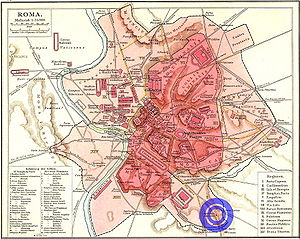
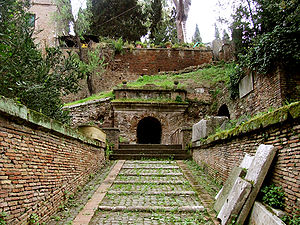
Scipio
-Classical:* Scipio, a representation of the Cornelii Scipiones, branch of the illustrious Cornelii family from Ancient Rome.* Scipio Africanus, Roman general who defeated Hannibal at Zama, the final battle of the Second Punic War....
family during the Roman Republic
Roman Republic
The Roman Republic was the period of the ancient Roman civilization where the government operated as a republic. It began with the overthrow of the Roman monarchy, traditionally dated around 508 BC, and its replacement by a government headed by two consuls, elected annually by the citizens and...
for interments between the early 3rd century BC and the early 1st century AD. Then it was abandoned and its location was lost within a few hundred years.
The tomb was rediscovered twice, the last time in 1780 and stands under a hill by the side of the road behind a wall at numbers 9 and 12 Via di Porta San Sebastiano, Rome
Rome
Rome is the capital of Italy and the country's largest and most populated city and comune, with over 2.7 million residents in . The city is located in the central-western portion of the Italian Peninsula, on the Tiber River within the Lazio region of Italy.Rome's history spans two and a half...
, where it can be visited by the public for a small admission price. The location was privately owned on discovery of the tomb but was bought by the city in 1880 at the suggestion of Rodolfo Amedeo Lanciani
Rodolfo Lanciani
Rodolfo Amedeo Lanciani was an Italian archaeologist, a pioneering student of ancient Roman topography, and among his many excavations was that of the House of the Vestals in the Roman Forum....
. A house was subsequently built in a previous vineyard there. The current main entrance to the tomb is an arched opening in the side of the hill, not the original main entrance. After discovery the few surviving remains were moved and interred with honor elsewhere or unknowingly discarded. The moveables: the one whole sarcophagus and the fragments of other sarcophagi
Sarcophagus
A sarcophagus is a funeral receptacle for a corpse, most commonly carved or cut from stone. The word "sarcophagus" comes from the Greek σαρξ sarx meaning "flesh", and φαγειν phagein meaning "to eat", hence sarkophagus means "flesh-eating"; from the phrase lithos sarkophagos...
, were placed on display in the hall of the Pio-Clementino Museum at the Vatican
Vatican Museums
The Vatican Museums , in Viale Vaticano in Rome, inside the Vatican City, are among the greatest museums in the world, since they display works from the immense collection built up by the Roman Catholic Church throughout the centuries, including some of the most renowned classical sculptures and...
in 1912. The sepulchre is a rock-cut chambered tomb on the interior, with the remains of a late façade on the exterior.
During the republic the tomb stood in a cemetery for notables and their families located in the angle between the Via Appia and the Via Latina
Via Latina
The Via Latina was a Roman road of Italy, running southeast from Rome for about 200 kilometers.It led from the Porta Latina in the Aurelian walls of Rome to the pass of Mons Algidus; it was important in the early military history of Rome...
on a connecting road joining the two just past the branch point. It was originally outside the city not far from where the Via Appia passed through the Servian Wall
Servian Wall
The Servian Wall was a defensive barrier constructed around the city of Rome in the early 4th century BC. The wall was up to 10 metres in height in places, 3.6 metres wide at its base, 11 km long, and is believed to had 16 main gates, though many of these are mentioned only from...
at the Porta Capena
Porta Capena
The Porta Capena was a gate in the Servian Wall near the Caelian Hill, in Rome, Italy according to Roman tradition the sacred grove where Numa Pompilius and the nymph Egeria used to meet. It was one of the main entries to the city of Rome, since it opened on the Appian Way...
. In subsequent centuries new construction changed the landmarks of the vicinity entirely. The wall was expanded to become the Aurelian Wall through which the Porta Appia admitted the Via Appia. The cemetery was now inside the city. The Appian gate today is called the Porta San Sebastiano
Porta San Sebastiano
Porta San Sebastiano is the modern name for the ancient Porta Appia, a gate in the Aurelian Wall of Rome, through which the Via Appia, now the Via di Porta San Sebastiano at that location, left the city in a southeasterly direction. It was refortified at the end of the 4th century and was again...
. Before it is the so-called Arch of Drusus
Arch of Drusus
The Arch of Drusus is an ancient arch in Rome, Italy, close to the First Mile of the Appian Way and next to the Porta San Sebastiano.The exact origins of the Arch are unclear. It is now generally agreed that it has nothing to do with Nero Claudius Drusus, the conqueror of the Germans...
, actually a section of aqueduct
Aqueduct
An aqueduct is a water supply or navigable channel constructed to convey water. In modern engineering, the term is used for any system of pipes, ditches, canals, tunnels, and other structures used for this purpose....
. The Via Appia at that location was renamed to the Via di Porta San Sebastiano. It passes through the Parco degli Scipioni where the cemetery once was located. The via is open to traffic. Most of it is lined by walls.
Period of use by the family
The tomb was founded around the turn of the 3rd century BC, after the opening of the Via Appia in 312 BC, probably by the then head of the family, Lucius Cornelius Scipio BarbatusLucius Cornelius Scipio Barbatus
Lucius Cornelius Scipio Barbatus was one of the two elected Roman consuls in 298 BC. He led the Roman army to victory against the Etruscans near Volterra...
, consul in 298 BC
298 BC
Year 298 BC was a year of the pre-Julian Roman calendar. At the time it was known as the Year of the Consulship of Barbatus and Centumalus...
. He was the earliest known occupant after his death around 280 BC. His sarcophagus was the only one to survive intact - it is now on show at the Vatican Museums
Vatican Museums
The Vatican Museums , in Viale Vaticano in Rome, inside the Vatican City, are among the greatest museums in the world, since they display works from the immense collection built up by the Roman Catholic Church throughout the centuries, including some of the most renowned classical sculptures and...
, re-united with its original inscription. According to Coarelli, the capacity of 30 burial places was reached, and the main body of the complex was essentially complete, by the middle 2nd century BC, but new burials continued at long intervals until the 1st century AD. During that time the tomb was a landmark in ancient Rome.
The tomb held the remains of one person outside the Scipio family: the poet Ennius, of whom there was a marble statue in the tomb according to Cicero. None of the more familiar Scipios (Africanus
Scipio Africanus
Publius Cornelius Scipio Africanus , also known as Scipio Africanus and Scipio the Elder, was a general in the Second Punic War and statesman of the Roman Republic...
, Asiaticus
Scipio Asiaticus
Lucius Cornelius Scipio Asiaticus was a Roman general and statesman. He was the son of Publius Cornelius Scipio and the older brother of Publius Cornelius Scipio Africanus...
and Hispanicus) were buried here, but according to Livy
Livy
Titus Livius — known as Livy in English — was a Roman historian who wrote a monumental history of Rome and the Roman people. Ab Urbe Condita Libri, "Chapters from the Foundation of the City," covering the period from the earliest legends of Rome well before the traditional foundation in 753 BC...
and Seneca
Seneca the Younger
Lucius Annaeus Seneca was a Roman Stoic philosopher, statesman, dramatist, and in one work humorist, of the Silver Age of Latin literature. He was tutor and later advisor to emperor Nero...
were buried in their villa at Liternum
Liternum
Liternum was an ancient town of Campania, Italy, on the low sandy coast between Cumae and the mouth of the Volturnus. It was probably once dependent on Cumae. In 194 BC it became a Roman colony....
.
The inscriptions on the sarcophagi also suggest that the hypogeum
Hypogeum
Hypogeum or hypogaeum literally means "underground", from Greek hypo and gaia . It usually refers to an underground, non-Christian temple or a tomb...
was complete about 150 BC. At that time it came to be supported by another quadrangular room, with no passage to the hypogeum - in this were buried a few others of the family. The creation of a solemn "rupestre" facade also dates to that period. The decoration is attributed to the initiative of Scipio Aemilianus, and is a fundamental example of Hellenization of Roman culture in the course of 2nd century BC. At that period the tomb became a kind of family museum, that perpetuated and publicised the deeds of its occupants.
The last well-known use of the tomb itself was in the Claudio
Claudius
Claudius , was Roman Emperor from 41 to 54. A member of the Julio-Claudian dynasty, he was the son of Drusus and Antonia Minor. He was born at Lugdunum in Gaul and was the first Roman Emperor to be born outside Italy...
-Nero
Nero
Nero , was Roman Emperor from 54 to 68, and the last in the Julio-Claudian dynasty. Nero was adopted by his great-uncle Claudius to become his heir and successor, and succeeded to the throne in 54 following Claudius' death....
nian period, when the daughter and the grandchild of Gnaeus Cornelius Lentulus Gaetulicus
Gnaeus Cornelius Lentulus Gaetulicus
Gnaeus Cornelius Lentulus Gaetulicus was a Roman general and politician. He was involved in a plot against the emperor Caligula and was executed after its discovery.-Biography:...
were buried here. These burials may be an attempt to emphasize for ideological reasons his descent from the Scipios; on the other hand, the latter speculation seems a harsh view of a man who, on the presumption that he was emotionally normal, must have been in grief at the death of his child. Repairs on the tomb continued until the 4th century AD. After then the mainly Christian Romans (who did not have the same loyalties to the traditions of pagan Rome) apparently stopped maintaining it and lost track of it.
Rediscoveries and publications

The owner of the property in 1614 did not alter or further publicize the tomb. He must have resealed it, hid the entrance and kept its location a secret, for whatever reasons, as it disappeared from public knowledge and was lost again, despite publication of the inscription. In 1780 the then owners of the vineyard, the brothers Sassi, who apparently had no idea it was there, broke into the tomb again during remodelling of their wine cellar. They opened it to the leading scholars of the day. Someone, perhaps them, fragmented the slabs covering the loculi, with the obvious intent of accessing the contents, being careful to preserve the inscriptions. If the act is to be attributed to the Sassi, and if the motive of treasure-hunting is to be imputed to them, they found no treasure. What they did find they turned over to the Vatican under Pope Pius VI, including the gold signet ring taken off the finger bone of Barbatus. Apparently some masonry was placed in the tomb with an obscure intent.
The tomb was published in Rome in 1785 by Francesco Piranesi
Francesco Piranesi
Francesco Piranesi was an Italian engraver and architect. He was the son of the more famous Giovan Battista Piranesi and continued his series of engravings representing monuments and ancient temples. He worked for a long period in France, where he lived during the French Revolution.Piranesi died...
in "Monumenti degli Scipioni." Francesco was completing a previous incomplete work by his father, Giovanni Battista Piranesi
Giovanni Battista Piranesi
Giovanni Battista Piranesi was an Italian artist famous for his etchings of Rome and of fictitious and atmospheric "prisons" .-His Life:...
, who died. The accuracy of the drawings in that work (actually, two works, by father and son) leaves much to be desired. For example, the corridor containing Barbatus' coffin is shown complete, when it has always ended in the rock ledge.
The tomb was subsequently neglected again (but not lost) until purchased by the city of Rome; in fact, there were reports of a gypsy family living in it. The tomb was restored in 1926 by the X Ripartizione of the Comune di Roma. At that time, masonry put in in 1616 and 1780 was removed. At the present time it contains duplicates of the material in the Vatican and is well cared for. Steel pins or beams support sections in danger of collapsing.
Art and architecture
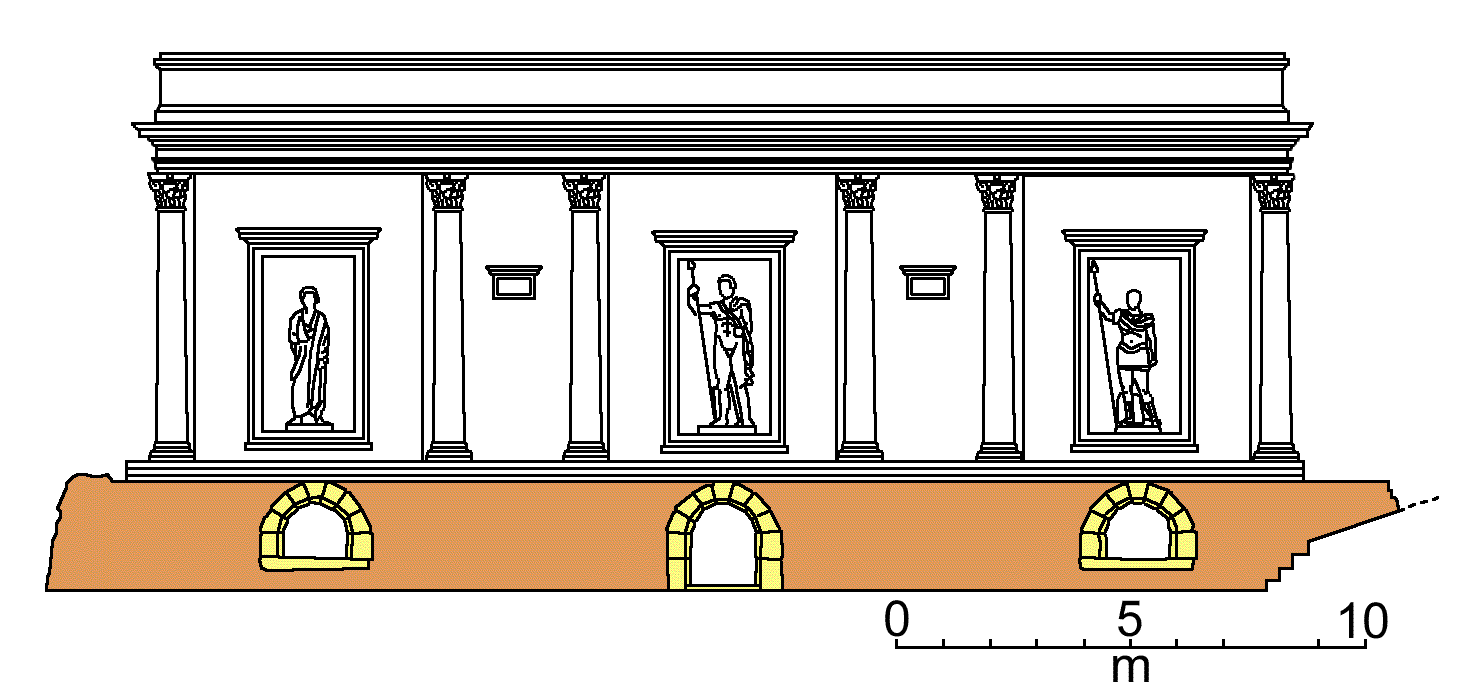
Tufa
Tufa is a variety of limestone, formed by the precipitation of carbonate minerals from ambient temperature water bodies. Geothermally heated hot-springs sometimes produce similar carbonate deposits known as travertine...
ledge on a large square plan, and a brick-built arcade from the later period, with a separate entrance. The view expressed by Simon Bell Platner (among others) that the tomb was built over a tufa
Tufa
Tufa is a variety of limestone, formed by the precipitation of carbonate minerals from ambient temperature water bodies. Geothermally heated hot-springs sometimes produce similar carbonate deposits known as travertine...
quarry is purely conjectural. No evidence exists either for or against.
The central room is divided by four large pilasters, repaired in the course of excavations to ensure the hypogeum did not collapse, with 4 long arcades along the sides and two central galleries that cross each other at right angles, giving the appearance of a grid plan.
The façade faced north-east, but only a small part of its right hand end survives, with few remains of wall paintings. It was made up of a high podium
Podium
A podium is a platform that is used to raise something to a short distance above its surroundings. It derives from the Greek πόδι In architecture a building can rest on a large podium. Podia can also be used to raise people, for instance the conductor of an orchestra stands on a podium as do many...
bordered by severe cornices, in which were three ashlar arches made of Aniene
Aniene
-External links:* http://www.humnet.ucla.edu/humnet/horaces-villa/glossary/Anio.gloss.html*...
tufa
Tufa
Tufa is a variety of limestone, formed by the precipitation of carbonate minerals from ambient temperature water bodies. Geothermally heated hot-springs sometimes produce similar carbonate deposits known as travertine...
: one led to the entrance of the hypogeum (central), one to the new room (right hand), while the third (left hand) led nowhere. This base was entirely covered in frescoes, of which only small pieces remain, showing three layers: the two oldest (from about the middle of the 2nd century BC) show historical scenes (some soldier figures can be recognised), while the last, the most recent, has a red simple decoration with stylized waves (1st century AD).
More spectacular was the upper part of the façade, with a tripartite view, semicolumns and 3 niches into which (according to Livy
Livy
Titus Livius — known as Livy in English — was a Roman historian who wrote a monumental history of Rome and the Roman people. Ab Urbe Condita Libri, "Chapters from the Foundation of the City," covering the period from the earliest legends of Rome well before the traditional foundation in 753 BC...
) were placed the statues of Scipio Africanus
Scipio Africanus
Publius Cornelius Scipio Africanus , also known as Scipio Africanus and Scipio the Elder, was a general in the Second Punic War and statesman of the Roman Republic...
, his brother Scipio Asiaticus
Scipio Asiaticus
Lucius Cornelius Scipio Asiaticus was a Roman general and statesman. He was the son of Publius Cornelius Scipio and the older brother of Publius Cornelius Scipio Africanus...
and the poet Ennius
Ennius
Quintus Ennius was a writer during the period of the Roman Republic, and is often considered the father of Roman poetry. He was of Calabrian descent...
, author of a poem, Scipio.
On the left a large circular cavity has destroyed a corner of the tomb, probably by the construction and use of a lime kiln in the medieval period.
The so-called "Head of Ennius"
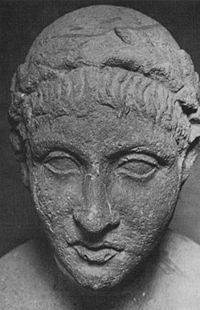
Vatican Museums
The Vatican Museums , in Viale Vaticano in Rome, inside the Vatican City, are among the greatest museums in the world, since they display works from the immense collection built up by the Roman Catholic Church throughout the centuries, including some of the most renowned classical sculptures and...
. Discovered in 1934, they were immediately stolen. The first head (24 cm high) has come to be called Ennius, who had a whole statue on the hypogeum façade according to Livy, but this attribution is incorrect, since the sources state Ennius's statue was in marble not tufa. It is unclear where in the tomb the heads were found, as they are probably portraits of another occupant of the tomb. The slightly inclined position of the neck has caused some to believe the first head is part of a larger statue, perhaps a reclining feasting figure from a sarcophagus lid, a type common in southern Etruria
Etruscan art
Etruscan art was the form of figurative art produced by the Etruscan civilization in central Italy between the 9th and 2nd centuries BC. Particularly strong in this tradition were figurative sculpture in terracotta and cast bronze, wall-painting and metalworking .-History:The origins of...
from the start of the 3rd century BC.
The head's modelling is in essence but effective, with a roundish face, swollen lips, wide nose and the large eyelids. The hair is indicated very vaguely and the head bears a laurel wreath with small leaves and foliage. Scholars propose dating it to the end of the 2nd century BC, when the Etruscan style of Latium underwent its first Greek influences.
Sarcophagi and inscriptions
The 30 resting places approximately correspond to the number of Scipiones who lived between the beginning of the 3rd and the middle of 2nd century BC, according to Coarelli. There are two types of sarcophagi - "monolithic" (i.e.; carved from a single block of tufaTufa
Tufa is a variety of limestone, formed by the precipitation of carbonate minerals from ambient temperature water bodies. Geothermally heated hot-springs sometimes produce similar carbonate deposits known as travertine...
) and "constructed." The latter type, which is in the majority, is an arched recess sunk into the wall in which the deceased was placed, and the opening covered by an inscribed slab with the letters painted red. English writers typically called these recesses "loculi". The recesses stand where they were, but the slabs have been moved to the Vatican. The monolithic sarcophagus of Barbatus was at the end of a corridor, in line with what once may have been a window, now the main entrance. The other sarcophagi of both types were added later as further shafts and rooms were sunk for the purpose.
The most important sarcophagi are those of Scipio Barbatus, now at the Vatican Museums, and that considered to belong to Ennius, both of substantial bulk. They do not entirely correspond with Etruscan sculpture, but show the elements of originality in Latin
Latium
Lazio is one of the 20 administrative regions of Italy, situated in the central peninsular section of the country. With about 5.7 million residents and a GDP of more than 170 billion euros, Lazio is the third most populated and the second richest region of Italy...
and particularly Roman culture, and are comparable with other Roman tombs (such as the Esquiline Necropolis
Esquiline Necropolis
The Esquiline Necropolis was a prehistoric necropolis on the Esquiline in Rome, in use until the end of the 1st century AD....
) in other cities such as Tusculum
Tusculum
Tusculum is a ruined Roman city in the Alban Hills, in the Latium region of Italy.-Location:Tusculum is one of the largest Roman cities in Alban Hills. The ruins of Tusculum are located on Tuscolo hill—more specifically on the northern edge of the outer crater ring of the Alban volcano...
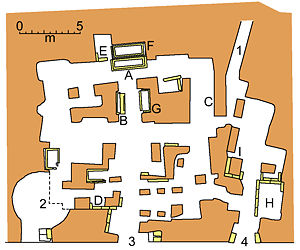
Sarcophagus of Scipio Barbatus (A)
The name is incised on the lid (CILCorpus Inscriptionum Latinarum
The Corpus Inscriptionum Latinarum is a comprehensive collection of ancient Latin inscriptions. It forms an authoritative source for documenting the surviving epigraphy of classical antiquity. Public and personal inscriptions throw light on all aspects of Roman life and history...
VI 1284) and the epitaph (CIL
Corpus Inscriptionum Latinarum
The Corpus Inscriptionum Latinarum is a comprehensive collection of ancient Latin inscriptions. It forms an authoritative source for documenting the surviving epigraphy of classical antiquity. Public and personal inscriptions throw light on all aspects of Roman life and history...
VI 1285) on the front of the only intact sarcophagus (some of the decorative detail has been restored). The letters were originally painted red. A Doric-style decorative panel is above the inscription featuring roses alternating with column-like triglyphs. The top of the sarcophagus is modeled as a cushion.
Sarcophagus of Lucius Cornelius Scipio (B)
The name is on a lid fragment (CILCorpus Inscriptionum Latinarum
The Corpus Inscriptionum Latinarum is a comprehensive collection of ancient Latin inscriptions. It forms an authoritative source for documenting the surviving epigraphy of classical antiquity. Public and personal inscriptions throw light on all aspects of Roman life and history...
VI 1286) and the epitaph on a slab fragment (CIL
Corpus Inscriptionum Latinarum
The Corpus Inscriptionum Latinarum is a comprehensive collection of ancient Latin inscriptions. It forms an authoritative source for documenting the surviving epigraphy of classical antiquity. Public and personal inscriptions throw light on all aspects of Roman life and history...
VI 1287). The name is painted in red letters. They hang on the wall of the museum.
Sarcophagus of Publius Cornelius Scipio, Flamen Dialis (C)
All that remains of the sarcophagus, now in the Vatican, is two fragments of a stone plate containing the engraved inscription, considered one inscription, CILCorpus Inscriptionum Latinarum
The Corpus Inscriptionum Latinarum is a comprehensive collection of ancient Latin inscriptions. It forms an authoritative source for documenting the surviving epigraphy of classical antiquity. Public and personal inscriptions throw light on all aspects of Roman life and history...
VI 1288. The break obscures a few letters easily and comprehensibly restored.
Sarcophagus and inscription of Lucius Cornelius Scipio, son of Asiaticus (D)
The inscription on the sarcophagus (CILCorpus Inscriptionum Latinarum
The Corpus Inscriptionum Latinarum is a comprehensive collection of ancient Latin inscriptions. It forms an authoritative source for documenting the surviving epigraphy of classical antiquity. Public and personal inscriptions throw light on all aspects of Roman life and history...
VI 1296) survives in the Vatican and identitifes the deceased as Lucius Cornelius L.f. P.n. Scipio, probably the second generation of the Cornelii Scipiones Asiatici (Lucius Cornelius Scipio Asiaticus II). See under Scipio Asiaticus.

